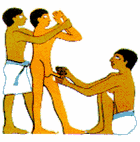|
Development of Sexual Behavior
|
|
Stages of Development
|
|
Adolescence
|
|
   
|
|
Symbols of Initiation (from the left) 1. Mask worn during a tribal initiation ceremony in Africa.
2. Circumcision of a male youth in ancient Egypt 3. Jewish bar mitzvah 4. Christian confirmation.
|
|
Adolescence (lat. adolescere: to grow up) is the period of life between puberty and adulthood. In the last several centuries, this period has become rather extended, but throughout most of human history it was relatively short. Indeed, even today some traditional, pre-industrial cultures in various parts of the world do not recognize an adolescence in our modern sense. Instead, they use so-called initiation rites to confer the status of adults on their children as soon as they reach puberty. Some of these ancient rites have survived in modern Western countries, but have lost much of their original meaning: The Jewish bar mitzvah and the Christian confirmation, for example, are now mostly symbolic ceremonies. They reaffirm the faith and signalize acceptance by the community, but they have no other important social consequences.The young people remain adolescents, subject to all sorts of restrictions and without the rights of adults. Indeed, it may take many years before they can “stand on their own two feet”, complete their studies, find their own living quarters, and become financially self-supporting. In other words: Puberty normally begins in a person's early teens and ends a few years later. Adolescence begins with puberty and today may very well last a decade or more.
Puberty is a process of physical maturation which produces the secondary sexual characteristics and leads to fertility. In contrast, adolescence is better described as a process of psychological and social maturation which leads to full citizenship. Puberty is a biological phenomenon, adolescence a cultural one.
Still, this extended period is also a time when gender role behavior and erotic behavior continue to develop and when reproductive behavior may become another very important issue. The following sections will discuss this in detail.
|